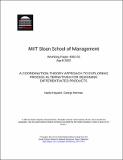| dc.contributor.author | Hayashi, Naoki | |
| dc.contributor.author | Herman, George | |
| dc.date.accessioned | 2002-08-12T16:38:02Z | |
| dc.date.available | 2002-08-12T16:38:02Z | |
| dc.date.issued | 2002-08-12T16:38:12Z | |
| dc.identifier.uri | http://hdl.handle.net/1721.1/1573 | |
| dc.description.abstract | This paper describes a new systematic method for
exploring and evaluating alternatives of a product design
process for differentiated products - those that share some
elements but also have differentiating features. Based on
coordination theory, the method clarifies the opportunities
and risks of process alternatives. The method consists of
three steps:
1) finding applicable differentiation approaches,
2) finding applicable patterns of process
coordination, and
3) evaluating total costs of the process
alternatives.
We categorized the differentiation approaches as a
taxonomy of design processes; the taxonomy includes
approaches of adding or removing differentiating elements
or sorting results. We also categorize how these are limited
by type of interim resource in a design process. We outline
three patterns of process coordination and how this
interacts with the choice of product differentiation
approaches. We show how the process alternatives vary in
the success rate of the coordination and how this
probability affects total cost of executing a design process.
It raises an awareness of the importance of managing
dependencies between activities, which many process
analyses don?t focus on.
We also show how to calculate the success rate
associated with varying the coordination cost or how to
calculate coordination cost associated with a desired
success rate. These calculated values indicate ?break-even
points? for the cost of the process.
| en |
| dc.format.extent | 721008 bytes | |
| dc.format.mimetype | application/pdf | |
| dc.language.iso | en_US | |
| dc.relation.ispartofseries | MIT Sloan School of Management Working Paper;4362-02 | |
| dc.subject | Product design | en |
| dc.subject | Coordination theory | en |
| dc.subject | Process analysis | en |
| dc.title | A Coordination-Theory Approach to Exploring Process Alternatives for Designing Differentiated Products | en |

